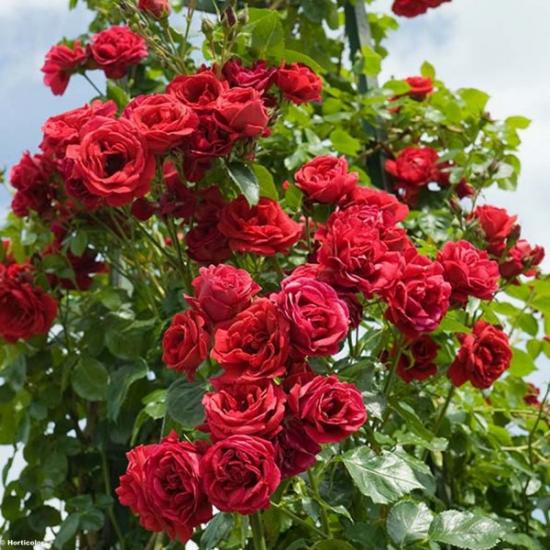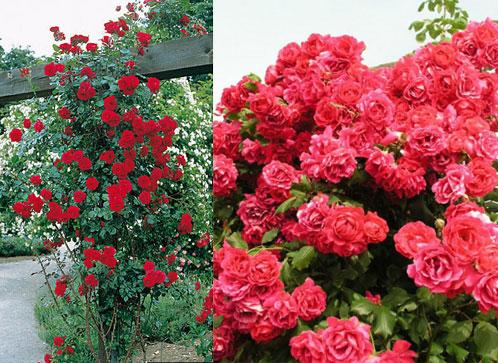Climbing rose Sympathy: growing features

Quite often in garden plots you can find beautiful climbing rose. They are used as an addition to landscape design, for vertical or horizontal gardening. To get gorgeous buds you need to know how to properly care for them.
Content:
- Climbing rose Sympathy: description
- Growing rules and place for planting
- How to care for the climbing rose Sympathy
Climbing rose Sympathy: description
Climbing roses are perennial flowering plants. This garden rose has double, large dark red flowers, which reach 8-10 cm in diameter. Fragrant flowers look great against the background of dark green leaves. The height of the plant is about 4.5 m, and the diameter of the bush can reach 2 meters.

Due to this size, these roses are used to decorate fences and walls of houses. Unlike classic roses, climbing roses roses grow and develop quickly. This is a long-flowering plant. The rose begins to bloom in June and ends in September-October. When exposed to bright sun, the petals do not fade or become stained after rain. Also, the plant is not afraid of severe frosts.
Growing rules and place for planting
Rose Sympathy does not tolerate cold winds, so it should be planted in a sunny place. With good lighting after planting, the rose will bloom the next year. Climbing roses do not require much space. It is best to plant in the fall. Before the onset of frost, the first shoots will appear and will grow until winter.If you plant a rose in the spring, it will grow a little later. At the same time, you will have to take care of it more carefully. Before planting, seedlings need to be soaked in water for a day. Cut the roots and shoots into two buds. Before planting the plant, you need to make a hole measuring 50x50 cm. You should add fertilizers: manure, lime, superphosphate and wood ash, and then water. The soil should be moist and drained. Climbing rose grows well on loamy and humus-rich soils. The root must be covered with a layer of soil of at least 10 cm. When planting more than one plant, the distance between them should be about one meter.
Video on how to propagate the Sympathy rose:
Then, after planting, it is necessary to cut off the above-ground part by 15-20 cm. This is done so that the rose grows well and blooms profusely. If a rose is planted to decorate any objects, then it should be planted at a distance of 45-50 cm from the object. It is recommended to mulch the soil under the plants using sawdust, straw or grass. Climbing roses are propagated by cuttings. You can use both winter and summer cuttings. Reproduction can begin in mid-June. Cuttings should be taken from healthy plants after flowering. One cutting must have at least four buds. Leaves should be removed from the bottom of the plant. Use sand with a 1 cm layer of soil as a substrate. It can be grown in a pot, box or other container. Cutting Cover the top with a jar and place in a shaded place. Water moderately. Use fertilizers if necessary.
How to care for the climbing rose Sympathy
Caring for a rose Sympathy consists of watering, weeding, fertilizing and pruning.
The plant rarely needs to be watered.1-2 times every 2 weeks will be enough. Immediately after watering, mulch the soil. There is no need to fertilize for the first two years. At this time it is better to feed with a flower mixture. From the third year of life, you need to use complex fertilizers. Plants must be weeded regularly. To form a crown, you should regularly trim the rose. In spring it is necessary to prune weak branches.

They also prune shoots that have already bloomed. As a result, new shoots will form, which will lead to rejuvenation of the bush. The level of flowering of the plant will depend on the procedure. The main pests and diseases of roses are: spider mites, aphids, and powdery mildew. Powdery mildew is characterized by the appearance of white spots on the leaves of climbing roses. This is especially observed in humid and very hot weather. At the same time, plant growth stops and flowering deteriorates. If powdery mildew appears for the first time, then you can get rid of it using Bordeaux mixture. Brown spots may also appear on the bark of plants, which begin to darken over time. These are signs of bark cancer. They can be discovered in the spring after the cover is removed. In this case, it is necessary to prune the damaged shoots.
When covering for the winter, it is important not to allow excess moisture. Decoctions of horsetail or nettle will help get rid of pests. If most of the plant is affected by pests, it is recommended to use insecticides.
It is important to promptly identify diseases and pests and take appropriate measures to prevent the death of the flower. This is a winter-hardy plant, but in regions with severe frosts, it is better to cover the climbing rose. Preparations for winter need to be carried out from August.At this time, loosening, fertilizing and watering should be completed. When the temperature drops below 5 degrees, you can begin to cover the soil. You shouldn't do this before.
Preparations for winter should be carried out in dry weather. Remove the plants from their supports and remove damaged shoots. Then tie the lashes with rope and press them into winter. To do this, you can use wooden or metal hooks. Dry leaves or spruce branches should be placed on top of the lashes. If climbing roses are placed on a structure, you can insulate them without removing them. You need to secure the spruce branches with twine and wrap them with agrofibre. Among a wide variety of flowering plants climbing roses are the most gorgeous. With their help you can decorate columns, trellises, arches, the wall of a house, a gazebo, etc. Not only are they pleasing to the eye with their beautiful colors, but they also create cool spaces on hot days.
Interesting information about the vegetable garden










